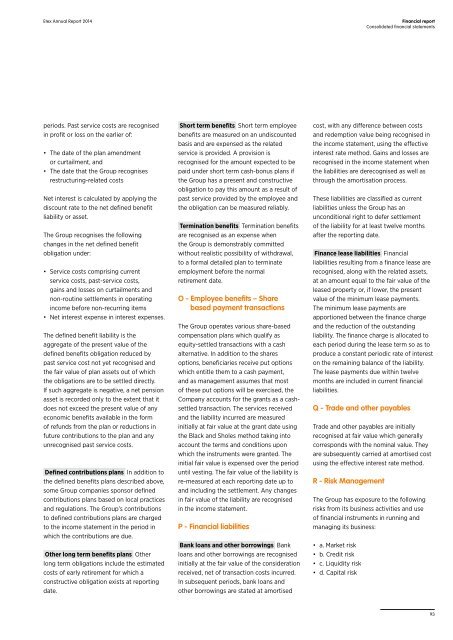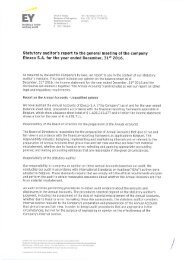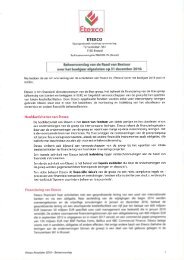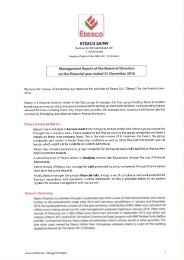Annual Report 2014
This is the 2014 annual report of Etex Group
This is the 2014 annual report of Etex Group
You also want an ePaper? Increase the reach of your titles
YUMPU automatically turns print PDFs into web optimized ePapers that Google loves.
Etex <strong>Annual</strong> <strong>Report</strong> <strong>2014</strong><br />
Financial report<br />
Consolidated financial statements<br />
periods. Past service costs are recognised<br />
in profit or loss on the earlier of:<br />
• The date of the plan amendment<br />
or curtailment, and<br />
• The date that the Group recognises<br />
restructuring-related costs<br />
Net interest is calculated by applying the<br />
discount rate to the net defined benefit<br />
liability or asset.<br />
The Group recognises the following<br />
changes in the net defined benefit<br />
obligation under:<br />
• Service costs comprising current<br />
service costs, past-service costs,<br />
gains and losses on curtailments and<br />
non-routine settlements in operating<br />
income before non-recurring items<br />
• Net interest expense in interest expenses.<br />
The defined benefit liability is the<br />
aggregate of the present value of the<br />
defined benefits obligation reduced by<br />
past service cost not yet recognised and<br />
the fair value of plan assets out of which<br />
the obligations are to be settled directly.<br />
If such aggregate is negative, a net pension<br />
asset is recorded only to the extent that it<br />
does not exceed the present value of any<br />
economic benefits available in the form<br />
of refunds from the plan or reductions in<br />
future contributions to the plan and any<br />
unrecognised past service costs.<br />
Defined contributions plans In addition to<br />
the defined benefits plans described above,<br />
some Group companies sponsor defined<br />
contributions plans based on local practices<br />
and regulations. The Group’s contributions<br />
to defined contributions plans are charged<br />
to the income statement in the period in<br />
which the contributions are due.<br />
Other long term benefits plans Other<br />
long term obligations include the estimated<br />
costs of early retirement for which a<br />
constructive obligation exists at reporting<br />
date.<br />
Short term benefits Short term employee<br />
benefits are measured on an undiscounted<br />
basis and are expensed as the related<br />
service is provided. A provision is<br />
recognised for the amount expected to be<br />
paid under short term cash-bonus plans if<br />
the Group has a present and constructive<br />
obligation to pay this amount as a result of<br />
past service provided by the employee and<br />
the obligation can be measured reliably.<br />
Termination benefits Termination benefits<br />
are recognised as an expense when<br />
the Group is demonstrably committed<br />
without realistic possibility of withdrawal,<br />
to a formal detailed plan to terminate<br />
employment before the normal<br />
retirement date.<br />
O - Employee benefits – Share<br />
based payment transactions<br />
The Group operates various share-based<br />
compensation plans which qualify as<br />
equity-settled transactions with a cash<br />
alternative. In addition to the shares<br />
options, beneficiaries receive put options<br />
which entitle them to a cash payment,<br />
and as management assumes that most<br />
of these put options will be exercised, the<br />
Company accounts for the grants as a cashsettled<br />
transaction. The services received<br />
and the liability incurred are measured<br />
initially at fair value at the grant date using<br />
the Black and Sholes method taking into<br />
account the terms and conditions upon<br />
which the instruments were granted. The<br />
initial fair value is expensed over the period<br />
until vesting. The fair value of the liability is<br />
re-measured at each reporting date up to<br />
and including the settlement. Any changes<br />
in fair value of the liability are recognised<br />
in the income statement.<br />
P - Financial liabilities<br />
Bank loans and other borrowings Bank<br />
loans and other borrowings are recognised<br />
initially at the fair value of the consideration<br />
received, net of transaction costs incurred.<br />
In subsequent periods, bank loans and<br />
other borrowings are stated at amortised<br />
cost, with any difference between costs<br />
and redemption value being recognised in<br />
the income statement, using the effective<br />
interest rate method. Gains and losses are<br />
recognised in the income statement when<br />
the liabilities are derecognised as well as<br />
through the amortisation process.<br />
These liabilities are classified as current<br />
liabilities unless the Group has an<br />
unconditional right to defer settlement<br />
of the liability for at least twelve months<br />
after the reporting date.<br />
Finance lease liabilities Financial<br />
liabilities resulting from a finance lease are<br />
recognised, along with the related assets,<br />
at an amount equal to the fair value of the<br />
leased property or, if lower, the present<br />
value of the minimum lease payments.<br />
The minimum lease payments are<br />
apportioned between the finance charge<br />
and the reduction of the outstanding<br />
liability. The finance charge is allocated to<br />
each period during the lease term so as to<br />
produce a constant periodic rate of interest<br />
on the remaining balance of the liability.<br />
The lease payments due within twelve<br />
months are included in current financial<br />
liabilities.<br />
Q - Trade and other payables<br />
Trade and other payables are initially<br />
recognised at fair value which generally<br />
corresponds with the nominal value. They<br />
are subsequently carried at amortised cost<br />
using the effective interest rate method.<br />
R - Risk Management<br />
The Group has exposure to the following<br />
risks from its business activities and use<br />
of financial instruments in running and<br />
managing its business:<br />
• a. Market risk<br />
• b. Credit risk<br />
• c. Liquidity risk<br />
• d. Capital risk<br />
93

















